Carnation
Carnation
- Varieties
- Soil and climate
- Cultural operations
- Polyhouse structures
- Propagation
- Land preparation
- Bed preparation
- Spacing and planting
- Staking
- Pinching
- Disbudding
- Nutrient management
- Water management
- Disease management
- Vascular wilt (F.oxysporum f.sp. dianthi)
- Bacterial wilt (Pseudomonas caryophylli)
- Leaf spots (Alternaria dianthi and A.dianthicola)
- Foot rot
- Flower rot (Botrytis cinerea)
- Disease chart
- Pest management
- Thrips - Thrips tabaci
- Two spotted spider mite - Tetranychus urticae
- Bud borer - Helicoverpa armigera
- Nematodes
- Harvest
- Post harvest operations
- Market and trade
- Related Resources
Carnation is one of the most important cut flowers in the world. They are also called ‘clove gilly-flowers’, divine flowers, clove pinks and gilly flowers. Botanical name of carnation is Dianthus caryophyllus L.
Varieties
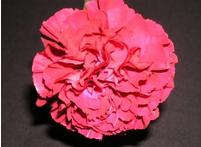 Carnation varieties can be demarcated into three main groups depending upon flower size and their use.
Carnation varieties can be demarcated into three main groups depending upon flower size and their use.
- Standard carnation - These have single large flower on an individual stem used as cut flower.
- Spray carnation - Spray carnation is generally a bunch of flowers on short branches of a single stalk. The flowers are small and compact on each branch.
- Micro carnation - These have shorter stems and higher production than spray varieties. These are used as ornamental pot plants besides its utility in flower arrangement.
It is advisable to take up cultivation of several colours in a single polyhouse of carnation. Market demand exists for several colours.
New cultivars developed by various commercial companies of temperate countries are being imported and are grown in India. While selecting varieties for planting, besides color, care should be taken about their adaptability to tropical condition and resistance to disease. Nearly all new carnation varieties are protected by royalties; hence, growers particularly when producing for export purposes have to be very careful about procurement of the material from right sources.
List of some of the commercial breeders
|
Sl.No. |
Name of the variety |
Colour |
Breeders |
Suppliers |
|
1. |
IIHRP-1 |
Red |
I.I.H.R., Bangalore |
I.I.H.R., Bangalore |
|
2. |
Gaudina |
Red |
Hilverda B.V. |
KF Bio plants Pvt. Ltd. |
|
3. |
Cool |
Red |
Kooij & Zonen B.V |
Florance Flora |
|
4. |
Aicardi |
Red |
Selecta B.V. |
Nilgiris Flower Co. |
|
5. |
Ruphus |
Red |
Selecta B.V. |
Nilgiris Flower Co. |
|
6. |
Gravello |
Red |
Selecta B.V. |
Nilgiris Flower Co. |
|
7. |
Turbo |
Red |
Santamaria, B.V |
SPA Flora Pvt. Ltd |
|
8. |
Viking |
White |
Hilverda,B.V |
KF Bio plants Pvt. Ltd |
| 9. |
Indios |
White |
Kooij & Zonen B.V |
Florance Flora |
| 10. |
Madam Collettee |
White |
Selecta, B.V |
Nilgiris Flower Co. |
| 11. |
White Wedding |
White |
Kooij B.V. |
Florance Flora |
| 12. |
White Liberty |
White |
Kooij & Zonen B.V. |
Florance Flora |
| 13. |
Biezet |
Pink |
Hilverda,B.V. |
KF Bio plants Pvt. Ltd. |
| 14. |
Charment |
Pink |
Kooij & Zonen B.V |
Florance Flora |
| 15. |
Pink Shiva |
Pink |
Santamaria, B.V |
SPA Flora Pvt. Ltd |
| 16. |
Castellaro 2000 |
Pink |
Selecta, B.V. |
Nilgiris Flower Co |
|
17. |
Fortune |
Pink |
Selecta,B.V. |
Nilgiris Flower Co |
|
18. |
Hermes |
Yellow |
Selecta, B.V. |
Nilgiris Flower Co |
|
19. |
Yellow Liberty |
Yellow |
Kooij & Zonen B.V |
Florance Flora |
|
20. |
Victoria |
Yellow |
Selecta, B.V. |
Nilgiri’s Flower Co |
|
21. |
Diana |
Yellow |
Santamaria, B.V |
SPA Flora Pvt. Ltd |
|
22. |
Yellow dot com |
Yellow |
Hilverda, B.V |
KF Bio plants Pvt. Ltd |
|
23. |
Mora |
Bicolour |
Santamaria, B.V |
SPA Flora Pvt. Ltd |
|
24. |
Alibaba |
Bicolour |
Selecta, B.V. |
Nilgiris Flower Co |
|
25. |
Navidad |
Bicolour |
Selecta , B.V. |
Nilgiris Flower Co |
Soil and climate
The ideal climate for carnation production should have a cool but stable temperature, low humidity and long days with high light intensity. The standard carnation prefers a cooler climate than the spray varieties. During the production of flowers, the plants must be protected from rain and dew. Wet plants, especially wet buds and flowers are susceptible to fungal diseases.
Light
- Carnations are long day plants and require high light levels to produce high quality flowers.
- About 21500 Lux is considered to be the minimum natural light intensity required for adequate photosynthesis of carnations.
Cultural operations
Polyhouse structures
- Carnation has to be grown under protected structures to maintain the quality and yield. The greenhouse construction should be kept as simple as possible, but it should meet some elementary demands in order to maintain the right climate in the greenhouse.
- The plastic greenhouse should have 3 to 4 m3 of airspace per m2 of floor surface. This is equal to a gutter height of 2.5 to 3.5 meters as a minimum.
- When the greenhouse is too low, there will be high air humidity and high temperature which is not suitable for carnation.
- For good climate control/good ventilation, it is also important not to construct a too large greenhouse under one roof (maximum 100x50m = 5000 m2 per unit) and to make it possible to roll up the sides.
- The roofing material could be Low Density Polyethylene (LDPE) of 200-micron thickness. One kg of this material covers 5.37 sq.m. LDPE needs replacement once in three years.
Propagation
- Carnation (D.caryophyllus) for cutflower is multiplied through cuttings
- There are annual carnations that are multiplied by seeds. These annual carnations are suitable as potted ornamental plants.
- D.chinensis and D. barbatus are multiplied through seeds.
Land preparation
- Deep ploughing to be followed before preparation of beds.
- A well-drained porous soil with adequate organic matter content is required for good growth.
- As carnation has fibrous root system presence of sufficient amount of organic matter and microorganism activity in the soil is required for supporting growth of good root system.
- The optimum soil pH should be around 6.5.
- Addition of calcium carbonate or dolomite limestone corrects the acid condition and also supplies calcium and magnesium for plant nutrition.
- Addition of gypsum or use of acid forming fertilizers will also in turn reduce the soil pH if it is on higher side.
Bed preparation
- For better working, a bed of one meter width and convenient length is to be prepared. A working path of 50 cm. can be given between the beds.
- Raised beds are ideal for cultivation.
- Bed can be ideally prepared by mixing of well rotten coir pith/paddy husk/saw dust.
- Sufficient amount of compost and sand should be added depending upon the clay content of soil.
- Normally, a well-prepared bed should contain a mixture of soil, farmyard manure, sand and coir pith in a proportion of 4:2:1:1, respectively.
Spacing and planting
- Planting can be done in different spacing.
- Normally, 30-45 plants per sq.mt. is considered to be ideal.
- The different spacing followed based on branching habit of the plant is 15x8cm, 15x10cm, 15x15cm and 15x20cm.
- In case information is lacking about the plant habit 15x20cm spacing can be conveniently followed.
- Alternate planting in adjacent rows is beneficial in terms of reduced incidence of disease.
- Shading should be given in the beginning of the crop for few days.
- Care should be taken to maintain the humidity to prevent plants from drying.
Staking
- Carnation crop has the tendency to bend unless supported properly. Hence, the crop needs support while growing.
- Good supporting material is metallic wire woven with nylon mesh.
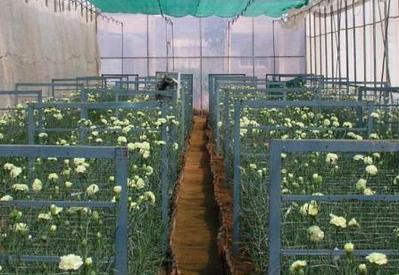
Pinching
- Pinching refers to removal of growing tip of main shoot encouraging growth of side shoots.
- Depending upon the need of crop spread and market demand, single, one and half and double pinches are given.
- When the plant attains six nodes, the first pinch is given. This is referred as ‘single pinch’. This would give rise to six lateral
- In a ‘one and half pinch’, 2-3 of these lateral shoots are pinched again.
- For the ‘double pinch’, all the lateral shoots are pinched off.
- Ideal time for pinching is morning.
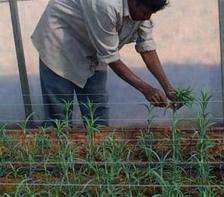
Disbudding
- In carnation, disbudding refers to removal of unwanted buds, so that the retained bud receives maximum food for the full development.
- In standard carnations, side buds are removed where as in spray carnations; the terminal buds are removed.
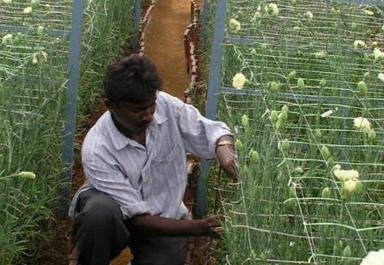
Nutrient management
- Carnation is highly responsive for fertilizer application. It is very sensitive for boron and calcium deficiency.
- Carnations require approximately equal parts of nitrogen and potash
- Supply of trace element boron and calcium in adequate quantity from the growth medium continuously is essential for healthy flowers
- For the first three weeks after planting, plant does not require any fertilizer.
Recommendation
- Nitrogen, Phosphorous and Potash is 30:20:30 gm/sq.mts per year.
- A basal dose of 20:20:10gm/sq.mts is given at the time of planting
- Remaining fertilizer is applied in equally distributed dosage over
Water management
During the first three weeks, overhead sprinklers are required to prevent young plants from drying out. Afterwards, drip irrigation can be used.
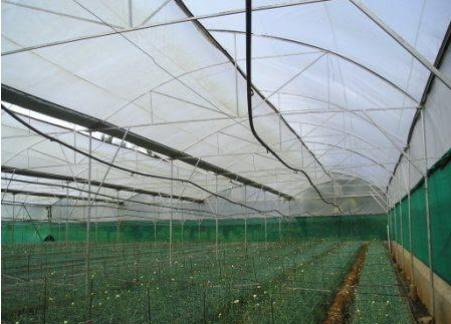
Disease management
Vascular wilt (F.oxysporum f.sp. dianthi)
Vascular wilt is the most troublesome disease of carnation.
Symptoms
- Infected plants first develop a dull green color, eventually wilt and turn straw-color. Symptoms often appear on one section of the plant.
- Plants may be attacked at any stage; young plants can suddenly dry up or older plants might develop a pale green color accompanied by wilting of lower leaves.
- A general wilting and death of the entire plant frequently follow this.
- In the initial stage of infection, plants may wilt in the middle of the day when the temperature is high and seem to recover at night. Some plants may show no signs of infection until they come into flower, when they suddenly collapse. When the stem is cut, a brown discoloration or streaking may appear in the vascular tissues.
Bacterial wilt (Pseudomonas caryophylli)
Besides, wilting of plants due to fungus, bacterial wilt caused by Pseudomonas is also being reported in carnation.
Symptoms
- Primary symptoms of infection include wilting of plants or shoots as well as splitting of the stems and yellow streaks in the vascular system.
- Tissue just under the epidermis is sticky and cutting across the stem shows discoloration and a bacterial ooze.
- Leaves turn gray-green then yellow and dry up. Rotting of roots and browning of vascular tissue are the other commonly seen symptoms.
- Cracks develop in internode tissue. Slime oozes out from these cracks when humidity is high.
- The disease appears to spread rapidly at high temperatures.
Leaf spots (Alternaria dianthi and A.dianthicola)
Symptoms
Pale tan to brown spots with purple borders appears on leaves. In severe cases the leaves get blighted due to merging of lesions.
Prevention/Control
- Efforts to maximize plant vigor by fertilizing and watering are helpful.
- However, watering should be done early in the day to give the foliage a chance to dry before night.
- It is necessary to pick and remove symptomatic leaves as soon as they develop.
- The infection can be managed through application of Captafol (0.2%) or Chlorothalonil (0.2%) or Iprodion formulations 0.2%.
Foot rot
Several soil borne fungi attack the roots and collar portions of carnation especially under high soil moisture conditions. The Phytophthora infections are caused by P. nicotianae var. nicotianae and P. nicotianae var parasitica.
Symptoms: Leaves and flower buds are infected under excessively wet weather conditions. Rotting of stem at soil level and ultimately the infected plants wilt. When roots are infected, the leaves gradually get discolored and start drying from bottom upwards. Soft rotting of young leaves and flower buds are the common symptoms.
Prevention/Control:
Since many of theses pathogens thrive well under high moisture conditions, moisture regulation is an important step in the control strategy.
The fungicides useful are Benomyl 0.2% or Iprodion formulations 0.2% against R. solani and S. rolfsii, whereas, metalaxyl + Mancozeb 0.2% and Fosetyl-Al 0.2% are effective in managing infections by Pythium and Phytophthora.
Flower rot (Botrytis cinerea)
- Flowers turn papery brown and become covered with gray, fuzzy masses of the fungus mycelium. Brown streaks develop on leaves.
- This disease is particularly troublesome during periods of extended cloudy, humid and wet weather.
Prevention/Control
- Good sanitation practices including grooming the plants and removing spent or senescing flowers can minimize the infection. It is also important to avoid wetting the flowers when watering plants.
- Adequate spacing between the plants can promote good air circulation.
- Control can also be achieved with the use of fungicide sprays as soon as symptoms are visible.
Disease chart
| Disease | Symptoms | Pathogen/Cause | Management |
|---|---|---|---|
| Alternaria Leaf Spot | Small purplish spot form on leaves. Their centers become brown and leaves become yellow. | Alternaria dianthicola or Alternaria dianthi | Apply Chlorothalonil (0.2%), Mancozeb (0.2%), Copper hydroxide (0.2%) or Mancozeb (0.2%) + Thiophanate Methyl (0.2%) to protect healthy plants. |
| Bacterial Wilt | Leaves turn gray-green then yellow and dry. Roots rot, vascular tissue browns and cracks develop in internode tissue. Slime oozes from these cracks when humidity is high | Pseudomonas caryophylli | Propagate in pasteurized raised beds. Use clean, disinfested tools. Destroy infected plants. |
Pest management
Thrips - Thrips tabaci
Yellowish nymphs and brown coloured adults damage growing buds and flowers by sucking the sap.
Symptoms
Damaged buds show brown streaks on light coloured flowers and white streaks on dark coloured flowers. In severe cases of attack flowers get distorted with burnt margins leading to considerable quality reduction.
Two spotted spider mite - Tetranychus urticae
It is a devastating pest on carnation grown under protected conditions especially during September-November and February-May.
Bud borer - Helicoverpa armigera
Eggs are laid singly on growing buds during September-October and damage continues up to February - March.
Symptoms
- Young larvae bore into growing buds and feed on petals making them hallow. Larvae also attack open flowers resulting in dropping of petals and significant yield loss.
Prevention/Control
- Collection and destruction of larvae reduces further infestation.
- Spray quinalphos 25 EC @ 2ml/l or methyl parathion 50 EC @ 1 ml/l or endosulphan 35 EC @ 2 ml/l at 15 days interval.
- Spray indoxacarb 14.5 SC @ 1 ml/l or thiodicarb 75 WP @ 1g/l if the incidence is severe.
- Spraying of of HaNPV (Helicoverpa armigera Nuclear Polyhedrosis Virus) @ 250 LE/ha followed by neem formulations1-2 ml/l or neem seed kernel extract 40g/l.
Nematodes
The root knot nematode cause small galls on the feeder roots affecting the uptake of nutrition and water.
Symptoms : The foliage shows nutritional deficiency like symptoms accompanied by reduced size of flowers
Management:
- Raise nursery in biopesticide enriched soil
- Apply farmyard manure enriched with bioagents Pochonia chlamydosporia and Paecilomyces lilacinus before planting
- Apply Carbofuran 3G at 5 gm per sqm at transplanting and repeat after 45 days
- Tolerant lines like IIHRP-1 can be used for cultivation that can withstand nematode infestation
Harvest
- After planting normally carnation takes 110-120 days to come to peak flowering. A commercial carnation plant is capable of producing 8 to 20 flowers per year.
- Depending upon market demand harvesting can be delayed by covering the buds with bud nets. When the buds start showing colour, bud nets can be put covering the entire flower bud, this also enhances the bud size besides regulating the flower development.
Post harvest operations
- Immediately after harvest, cut ends of the carnation flower stems should be placed in a bucket containing clean water or floral preservative of biocide and acidifying agent.
- These flowers are pre cooled as early as possible at 20C for two to four hours
- Only healthy and uniform cut flowers are graded based on stem length and bud size.
- As per the market requirement, bunch of 10, 15 or 20 flowers are tied with rubber band and the blooms covered with butter paper sleeves.
- Leaves on 1/3rd of the basal stem are removed and end of the stems trimmed.
- These bunched and trimmed flowers are immediately placed in a bucket of preservative solution prepared in de-ionized water again.
- A good preservative solution for carnations should be acidic (pH 4.5) with 2-5% sucrose and a biocide for pulsing.
Market and trade
The biggest consumer of carnation in terms of absolute quantity is the USA. But the most consumed per capita is by England. Carnations are still popular in Eastern Europe where they almost rival roses.
Source - E-Learning Module on Carnation Cultivation
Related Resources
अंतिम बेर संशोधित : 7/8/2022
This topic provides information on horse gram pack...
Package of practices and recent technologies adopt...
This topic explains about Improved Cultivation Pra...
This topic covers the details of cultivating Paddy...
